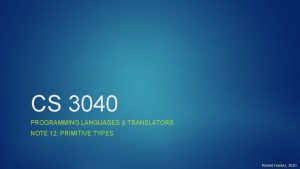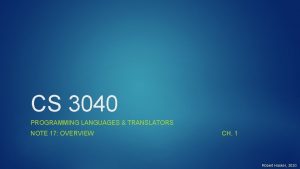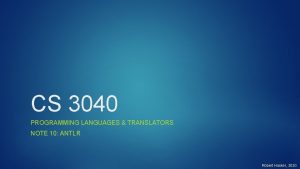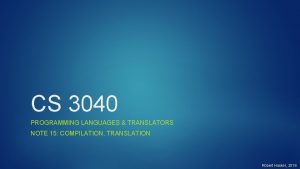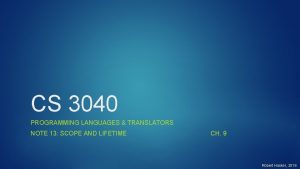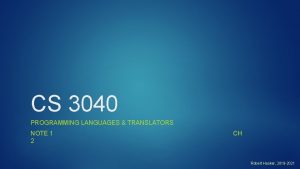CS 3040 PROGRAMMING LANGUAGES TRANSLATORS NOTE 14 MEMORY










- Slides: 10

CS 3040 PROGRAMMING LANGUAGES & TRANSLATORS NOTE 14: MEMORY MANAGEMENT Robert Hasker, 2019

Pointers Dangling pointers (dangerous) A pointer points to a heap-dynamic variable that has been deallocated Creating one (with explicit deallocation): a. Allocate a heap-dynamic variable and set a pointer to point at it: *a=new Node(10); b. Node Set a second pointer to the value of the first pointer: Node *b = a; c. Deallocate the heap-dynamic variable, using the first pointer: a; d. Use the second pointer: b->value = 42; delete Problem: what if another process (eg, graphical user interface code) runs here – may re-allocate the space pointed to by a

Pointers list Lost Heap-Dynamic Variables (wasteful) A heap-dynamic variable that is no longer referenced by any program pointer Creating one: void add_to_end(Node *list, int val) { Node *x = new Node; // node on heap for(x = list; x->next != NULL; x=x->next) ; x->next = new Node(val); // create new // space for original x now lost } Result: memory leak x

Pointers Evaluation of pointers: 1. 2. Problems: a. Dangling pointers b. Memory leaks c. Heap management overhead Claim: pointers are like goto's--they widen the range of cells that can be accessed by a variable 1. 3. This is overstated! W/o pointers: must allocate all data statically a. How to know how much needed? b. Result: waste space or unnecessary limits to data

Living with pointers Solution 1: manual memory management – works, but requires discipline Solution 2: automated garbage collection Need to be able to detect that memory is no longer in use Must be able to reorganize memory so can reuse the bits that are no longer in use One method: reference counters maintain a counter in every cell that store the number of pointers currently pointing at the cell When counter reaches 0, free the space Problems: Extra bits for counter in every object Overhead for every assignment Circular lists/mutual references cause problems Reference counters are rarely used!

Living with pointers Alternative solution: allocate until no available cells, then gather all garbage Known as “garbage collection” Common scheme: mark and sweep Set aside a bit for every object on the heap Often use the low order bit Initialize all objects to indicate they are “garbage” Trace each pointer into heap, clearing garbage bits Recursively clear garbage bits for those points Starting point: “alive” program variables Note compiler or runtime must track these alive variables! Return remaining objects (garbage) to available list

Marking Algorithm

Mark & Sweep, Continued Advantages no overhead until need to collect garbage little space overhead circular lists not a problem Disadvantages big cost to collection highest cost when you need it the most! that is, when you actually need the space is exactly when there’s the most data to search Almost impossible to use for real-time systems

Generational Collection Observation: new objects die quickly, “surviving” objects likely to survive for many more collections Divide heap into generations: youngest in G 0, G 1 containing only objects older than G 0, G 2 older objects than G 1, etc. Collecting: collect G 0 most frequently, G 0+G 1 less often, G 0+G 1+G 2 even less often, etc. start by collecting in G 0, move up only if that doesn’t give you enough space Issue: “alive” program variables not enough – also need to track entry points from Gi to G 0 for i > 0 But: such pointers are rare – most are set once and never changed Can use VM page locking: when change ptr on page, check reference and update list of entry points to each generation

GC Wrap-up Generational GC: little overhead in most cases Generational scheme may fail to reclaim unreachable objects – combine w/ full mark & sweep http: //msdn. microsoft. com/msdnmag/issues/1200/GCI 2/: . NET framework uses generational GC http: //www. devx. com/Java/Article/21977: also used in Sun’s Java Hot. Spot virtual machine What about real-time systems? predictability is key: incremental collection: run mark & sweep in parallel synchronization can make this expensive can take advantage of VM page locking to reduce costs dramatically! Conclusion: GC is not a horrible thing!











